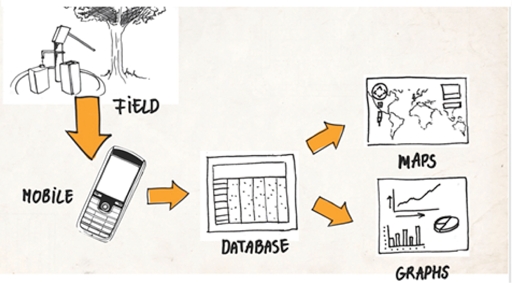13.3 National WASH Inventory and WASH Management Information System
The National WASH Inventory (NWI) was introduced to you in Study Session 3 as an integrated record of water supply, sanitation and hygiene service coverage data in Ethiopia. Its purpose was to establish, for the first time, a single comprehensive set of baseline data for the whole country. The first phase of the NWI, in 2010/2011, was a major undertaking, as you can see from the figures in Box 13.2. Financing came from federal and regional governments and development partners. It required surveying of more 730 woredas and 16,000 kebeles and involved approximately 70,000 data collectors, known as ‘enumerators’.
Box 13.2 National WASH Inventory: facts and figures
70,000 enumerators inventoried:
- 92,588 rural water supply schemes
- 1,605 town water supply schemes
- 30,000 schools
- 20,000 health institutions
- 12 million households.
Total cost: more than 100 million birr (which equalled US$ 5.3 million in 2013).
(Welle, 2013)
In the early phases, the data collection methods relied on paper-based surveys. Enumerators visited all rural community water schemes and urban water supply systems. Each water point was identified according to its geographical coordinates and information was collected on functionality, number of users and other details outlined above in Section 13.2.4. There were also household visits to survey WASH access and behaviours.
The paper-based system was found to be time-consuming, expensive and unreliable so, in a second phase in 2013/14, data from the Somali Region was collected using smartphone technology (Figure 13.5). Specially-trained enumerators visited households and water points to gather data which they recorded directly on their mobile phones using previously uploaded survey forms (Tatge, 2014). They saved the exact GPS location of water points and could take pictures too. Data from many sites could be collected and stored on a single phone, then later transferred via the internet (access permitting) to a database located on a server.

The enormous amount of data generated by an inventory of the size and scale of the NWI presents major challenges in organising, collating and storing it in a systematic and accessible way. This is the purpose of the WASH Management Information System. A management information system (MIS) is a computer-based system that provides managers with tools for collecting and organising information so that it supports their decision making. A MIS is used to record, process, integrate and store relevant data in such a way that it can be updated regularly and accessed by managers and other relevant stakeholders.
The WASH MIS is designed to be a repository for monitoring data and to enable production of reports at national, regional, zonal and woreda levels. The idea is that data can be extracted, collated with other data, and used to produce reports, graphs and maps to facilitate all aspects of programme management.
Two issues have been identified that affect the value of the NWI to WASH stakeholders: how to make the NWI results accessible to those who need them, and how to keep the data current (Welle, 2013). NWI data is currently in a database (using the Microsoft Access system) designed to enable data entry at regional level for the purpose of regular updating. However, to maximise its value, access should also be available to woreda staff. This requires the procurement of computers and staff training in database management. Making the data available in Excel format would make it more accessible to users, which could facilitate both regular updating of the system and the production of maps and other output reports. Despite these current limitations, the NWI and WASH MIS are significant steps towards achieving harmonised and aggregated data management and access by different stakeholders for informed planning and decision-making processes.
13.2.4 What is monitored in WASH?
